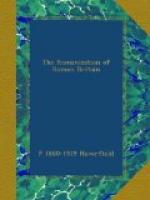[Footnote 1: For the New Forest ware see the Victoria Hist. of Hampshire, i. 326, and Archaeol. Journal, xxx. 319. The Brough brooches have been pointed out by Sir A.J. Evans, whose work on Late Celtic Art is the foundation of all that has since been written on it, but have not been discussed in detail.]
[Footnote 2: Victoria Hist. of Northamptonshire, i. 206-13; Artis, Durobrivae of Antoninus (fol. 1828).]
[Footnote 3: For the Belgic ‘Castor ware’ see the Belgian Bulletin des commissions royales d’art et d’archeologie (passim); H. du Cleuziou, Poterie gauloise (Paris, 1872), Fig. 173, from Cologne; Sammlung Niessen (Koeln, 1911), plates lxxxvii, lxxxviii; Brongniart, Traite des arts ceram., pl. xxix (Ghent and Rheinzabern). M. Salomon Reinach tells me that the ware is not infrequent in the departments of the valleys of the Seine, Marne, and Oise. The Colchester gladiator’s urn mentioning the Thirtieth Legion (C.R. Smith, Coll. Ant., iv. 82, C. vii. 1335, 3) may well be of Rhenish manufacture.]
[Footnote 4: This, or the corresponding scene of Perseus and Andromeda, is a favourite with artists in northern Gaul and Britain. It occurs on tombstones at Chester (Grosvenor Museum Catalogue, No. 138) and Trier (Hettner, Die roem. Steindenkmaeler zu Trier, p. 206), and Arlon (Wiltheim, Luciliburgensia, plate 57), and the Igel monument. For other instances see Roscher’s Lexikon Mythol., under ’Hesione’.]
[Illustration: FIG. 14. FRAGMENTS OF NEW FOREST POTTERY WITH LEAF PATTERNS. (From Archaeologia).]




